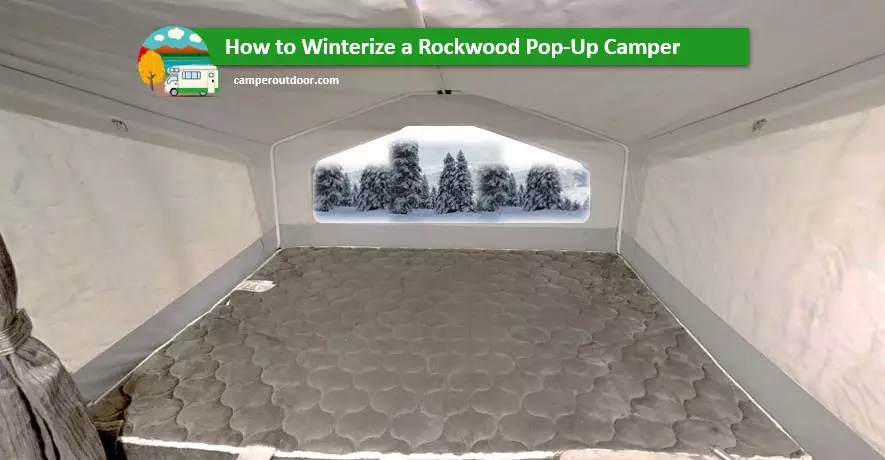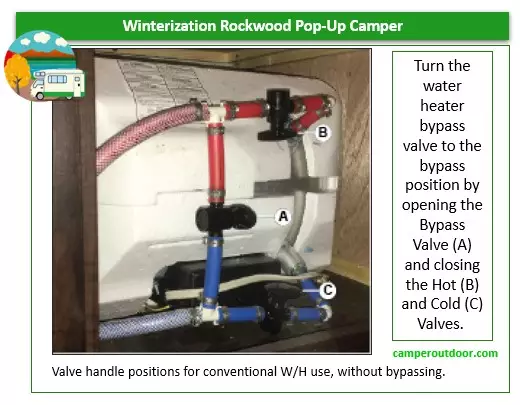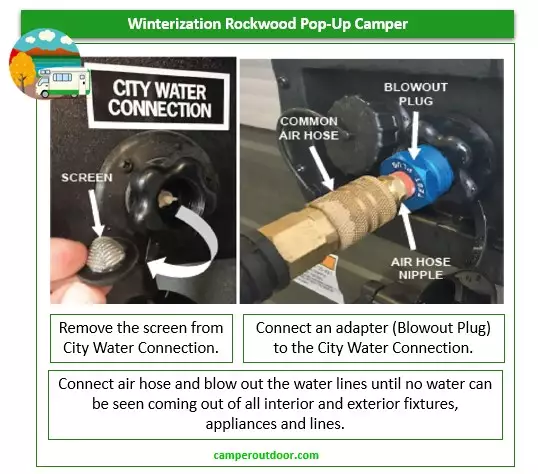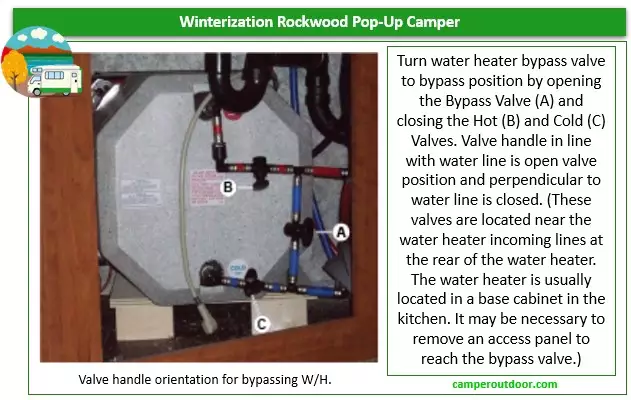As winter approaches, many RVers begin to think about how they will winterize their RVs, especially when is a pop-up camper. If you own a Forest River Rockwood pop up camper (Freedom series, High Wall series, Rockwood Roo, Rockwood Ultra Lite, etc.), there are some specific things you need to do to make sure your camper is ready for the cold weather, whether you are going to use it or not. In this article, learn How to Winterize a Rockwood Pop Up Camper, How to Store a Rockwood Pop Up Camper During Winter, and How to Winterize a Rockwood Pop Up Camper for Travel or Live In.
Table of Contents
Do You Have to Winterize a Rockwood Pop Up Camper?
Preparing these Rockwood Freedom, Rockwood Roo, Rockwood High Walls, Rockwood Ultra Lite, and Mini Lite Pop Up campers for winter to stay warm inside the camper is not as challenging as winterizing other pop up campers that do not have a furnace. What if you don’t plan to use your Rockwood during winter? Do you have to winterize a Rockwood pop up camper if you just going to store it?
Whether you plan on using your Rockwood tent camper or not, the water systems must be fully winterized with antifreeze to prevent freezing and bursting. We summarize the activities you should do to properly store the camper during winter and to prepare it for the winter getaway.
Also, if you plan to winterize your Rockwood pop-up camper for travel or live in, even when a pop-up camper has a furnace, proper insulation will keep the interior heated for the most challenging winter cold temperatures, providing comfort and relaxation for maximum enjoyment of your pop-up camper during the winter. So, the great advantage of a pop up camper like these ones is that it will be easy to stay warm.
Let’s see how to insulate, stay warm and winterize a Rockwood Pop-Up Camper.

How to Store a Rockwood Pop Up Camper During Winter
If you are not going to use your Rockwood and want to keep it safe from bursting, you will need to winterize. Therefore, you will need to winterize your Rockwood to store it during winter.
Here is this checklist to properly Store a Rockwood Pop Up Camper During Winter. Let’s see How to Winterize a Rockwood Pop Up Camper for winter storage.
- Start by giving your camper a good cleaning, inside and out. This will help get rid of any dirt, dust, or debris that could cause problems during the winter months.
- If you have an electric water heater, empty the tank and disconnect the power.
- If you have a gas water heater, turn off the gas.
- Next, you’ll need to empty out all the freshwater tanks and flush out the lines.
- Once the freshwater tanks are empty, you’ll need to fill them with RV antifreeze. So, drain the fresh water tank and add RV antifreeze to the tanks. This will help protect your plumbing during the cold weather.
- Now it’s time to move on to the grey water tank. You’ll need to drain it completely and then add a few gallons of RV antifreeze. Flush the toilet and add RV antifreeze to the holding tank.
- Disconnect the water lines from the faucets and add RV antifreeze to them.
- Don’t forget to winterize your furnace. Be sure to consult your owner’s manual for specific instructions on how to do this.
- Winterize the refrigerator by either turning off the power or disconnecting the propane.
- Once the antifreeze has been added to the plumbing system, you’ll need to inspect the RV roof and seal any cracks or holes. Inspect the roof and seal any cracks by applying RV roof sealant if needed. Also, inspect for RV refrigerator roof vent cover leaks. This will help prevent water from leaking into your Rockwood tent trailer and causing damage.
- Disconnect the battery/batteries and store them in a warm, dry, and ventilated place, free of moisture, at room temperature. Verify the status and recharge your deep-cycle RV batteries fully before storing them. Always fully recharge your batteries before storage, even if not winter time. Although a good deep cycle battery can be stored for up to 9 months without a recharge, it is highly recommended to recharge your stored batteries at least once every 2 or 3 months if stored at over 85°F (30°C) and more frequently if under cold weather.
- Another winter preparation task for your camper is to make sure the tires are in good condition. Cover your camper’s tires with tire covers to protect them from the cold weather. It’s also a good idea to store the camper on blocks to take some of the weight off of the tires. So, consider using RV leveling blocks if needed.
- Place a heavy-duty tarp over the top of your camper. This will help protect it from snow and ice Cover the air conditioner with a tarp or shrink wrap.
- Remove any perishable food from your camper’s refrigerator and freezer. Make sure that your camper is clean and free of any food to keep mice away from your camper.
- Prevent mold from growing inside your camper or inside from smelling to humidity by placing moisture collectors. These affordable moisture collector’s silica-gel based will keep the inside of the camper free from condensations preventing bad smell and furniture damage. How to Prevent Mold in an RV During Winter Storage
- Make sure all windows and doors are sealed tight.
- Cover the camper with a tarp or shrink wrap.
- Store the camper in a dry, protected area if possible.
By following these tips, you can winterize your Rockwood pop-up camper and be prepared for the cold weather.
Let’s continue reading How to Winterize a Rockwood Pop-Up Camper when we plan to use it for a trip.
How to Winterize a Rockwood Pop-Up Camper for Using
When parking your recreational vehicle in an unheated area during times of cold weather, the water system must be winterized. If the required winterization processes are not followed, the water system components will be damaged.
Keep in mind that a clothes washer, dishwasher, refrigerator with water/ice maker, or any other water storage device must be winterized. The manufacturer’s manual should have instructions. If no instructions are provided for winterizing the appliance, the antifreeze approach is advised.
If you plan on using your Rockwood tent camper during the winter, you will also need to winterize the plumbing. This can be done by adding non-toxic RV antifreeze to the water system and using space heaters to keep the pipes from freezing. You should also drain all of the water from the freshwater tank to prevent it from freezing and expanding, which could damage the tank.
If you own a Rockwood and want to be ready for winter, there are some things you need to do to winterize it. Here are some tips on winterizing a Rockwood Freedom, Rockwood HW, Rockwood Ultra Lite and Mini Lite, and a Rockwood Roo Pop Up camper for winter.
Let’s see How to Winterize a Rockwood Pop Up Camper to traveling during cold weather.
Winterize a Rockwood Pop Up Camper Plumbing System/Water System
This is a brief explanation for Winterize a Rockwood Pop Up Camper Plumbing System/Water System. In the following paragraphs, you will find a very thorough explanation of how to perform the winterization and de-winterization of a Rockwood camper.
- Drain the fresh water tank. To do this, open all the faucets in the RV and then open the drain valve on the freshwater tank. Once the tank is empty, close all the faucets and the drain valve.
- Next, you will need to disconnect the water line from the city water connection. Once the line is disconnected, open all the faucets in the RV again to allow any remaining water in the lines to drain out.
- Now that the fresh water tank is drained and the water lines are disconnected, it’s time to add non-toxic RV antifreeze to the system. RV antifreeze is specially formulated to protect your RV’s plumbing from freezing temperatures.
- To add non-toxic RV antifreeze to the system, simply pour it into the fresh water tank through the fill opening. Once the tank is full, turn on all the faucets in the RV and run the water until you see the colored antifreeze coming out.
- Once the antifreeze is coming out of all the faucets, turn them off and close the fresh water tank’s fill opening.
- Be sure to add RV antifreeze to all the plumbing lines of your Rockwood pop up camper. To do this, simply pour RV antifreeze into all the drains in the RV, including the shower, sinks, and toilets. Once the antifreeze is in the drains, run all the faucets in the RV for a few minutes to allow the antifreeze to reach all the fixtures. After a few minutes, turn off the faucets and your RV’s water system will be properly winterized.
- Don’t forget to winterize your Rockwood furnace. Be sure to consult your owner’s manual for specific instructions on how to do this, as depending on your Rockwood series, floorplan, and year, the furnace brand may differ.
Let’s step-by-step How to Winterize the Water System of a Rockwood pop up camper, according to the Forest River’s manual.
Winterizing Using Air Compressed
Let’s review the winterization and de-winterization of a Rockwood pop up camper by using air compressed.
- Never use car antifreeze. Only use non-toxic RV antifreeze in your RV potable (drinking) water systems. Mix the non-toxic RV antifreeze in the proportion highlighted by the antifreeze manufacturer to prevent burst piping, consequent leaks, and damage to your Rockwood pop up camper by improper camper plumbing winterization.
- Drain the fresh water tank
- Empty the waste water holding tanks.
- Set the bypass valve on the water heater by opening the Bypass Valve (A) and closing the Hot (B) and Cold (C) Valves, as shown in the pictures below.

- Remove the water heater. Consult the owner’s manual for your water heater.
- If your machine has a water filtration system, remove and discard the filter cartridge before replacing the canister. When de-winterizing, a new filter will be necessary.
- Open all interior and external fittings, including the low point drain, clothes washer supply lines, shower heads, and the toilet flush valve. If you have a clothes washer, run it on the warm cycle until no more water comes out, then spin it until the water is gone.
- To remove any water from the pipes, turn on the water pump for at least 30 seconds.
- Set the air pressure to no more than 30 PSI.

- The screen (see the picture above) should be removed from the City Water Connection. Connect a blowout plug (adapter) to the City Water Connection.
- Connect an air hose to the water lines and blow them out until no water can be seen flowing out of any interior or external fixtures, appliances, or lines.
- Remove the Blowout Plug from the City Water Connection, replace the Screen, and close all fixtures, fittings, and low point drains.
- Connect air to the Black Tank Flush inlet and flush water from that system if it is equipped with one. The Black Tank Flush system has no screen.
- Pour one quart of RV antifreeze into each interior and external drain, p-traps, and tank (if provided).
- Fill each toilet with 12-gallon antifreeze, shut the toilet flush valve, and pour one inch of antifreeze so the valve is covered with antifreeze.
Winterizing with RV Antifreeze Only
Let’s review the winterization and de-winterization of a Rockwood pop-up camper by using only non-toxic RV antifreeze (no air compressed).
- Purchase 4-6 gallons of non-toxic RV antifreeze.
- All tanks should be drained (fresh water and waste water holding tanks).
- By opening the Bypass Valve (A) and closing the Hot (B) and Cold (C) Valves, you may bypass the water heater.

- The valve handle in line with the water line is open, while the valve handle perpendicular to the water line is closed. (These valves are positioned at the back of the water heater near the incoming pipes.) In most kitchens, the water heater is housed in a base cabinet. To reach the bypass valve, an access panel may need to be removed.)
- Remove the water heater. Consult the owner’s manual for your water heater.
- If your machine has a water filtration system, remove and discard the filter cartridge before replacing the canister. When de-winterizing, a new filter will be necessary.
- Apply antifreeze to the water pump’s inlet using either: A. Turn on the neighboring valve, if one is available, and insert the winterization hose into the antifreeze container. B. Disconnect the water line from the pump inlet and attach a small length of hose to the bottle of antifreeze.
- Turn on the pump and open the cold water side of all interior and external faucets. Keep the faucets open until the antifreeze (usually pink in color) pours out. Rep with the hot water side.
- To winterize the black holding tank, flush the toilet until antifreeze is visible within the bowl then pour one gallon of antifreeze down the toilet. If available, use the toilet sprayer until antifreeze is detected.
- Pour one quart of RV antifreeze into each interior and external drain, p-traps, toilet, and tank (if fitted).
- Add 12-gallon antifreeze into each toilet, then close the flush valve and pour one inch of antifreeze to cover the valve.
- If you have a black tank flush system, use a hand pump to pump antifreeze into the Black Tank Flush inlet (available from your RV dealer).
Now we know how to properly winterize the water system. Let’s continue reading this article about How to Winterize a Rockwood Pop-Up Camper for more winterizing activities needed to prepare the Rockwood for the coldest season.
Maintain the Camper Electrical Wiring
When it comes to winterizing your Rockwood pop-up camper, there are a few other things you can do to make sure it stays in good condition.
First, you should cover any exposed electrical wiring with insulation tape to prevent any shorts from occurring. Then, you should also store all of your camping gear inside the camper, as this will help to protect it from the cold and dampness.
Prepare the Rockwood Pop Up Camper Tires for Cold temperatures
Cold weather can cause the air in the tires to condense, which can lead to flats. Be sure to check the pressure in the tires before heading out on any trips.
Finally, you should make sure the tires are inflated to the proper pressure, as this will help to prevent them from flat spots.
How To Prepare The Camper Tires For Winter
When temperatures start to dip in the fall, it’s time to start thinking about how to prepare the RV tires for winter. Here are some tips for winterizing a Rockwood Pop Up Camper:
- Check the air pressure in your tires. In colder weather, tires tend to lose air pressure more quickly, so it’s important to check them regularly and inflate them as needed.
- Consider investing in tire covers to protect your tires from weather and prolong their life.
- If you’ll be storing your Rockwood for the winter, make sure to do so on a level surface. This will help prevent your tires from developing flat spots.
- Be sure to inspect your tires before each trip, looking for any cracks or other signs of wear and tear. If you notice any damage, have the tires repaired or replaced before hitting the road.
Review Status and Charge of Deep Cycle Batteries when Winterizing a Rockwood
Batteries tend to lose their charge when temperatures drop. This especially affects lithium phosphate batteries, even if they are deep-cycle batteries for RVs. Wrongly, we often leave our batteries plugged in during the winter. And that deteriorates quite a lot of the batteries we use in the RV.
The best practice is to disconnect the RV battery or batteries during winter and store them in a warm, dry place. Verify the status and charge them before storing them.
If you want to hit the road in your Rockwood during winter, you should check if you have the right deep cycle batteries for camping and be sure you have them fully charged.
What are the Best Deep Cycle Batteries for RVs for Cold Weather?
When winterizing your RV, one of the most important things to consider is what kind of batteries you will need to keep everything running smoothly. There are a few different types of deep cycle RV batteries that are suitable for campers, but the best ones for cold weather are the AGM deep cycle batteries.
Deep cycle batteries are designed to discharge and recharge multiple times during the years which is perfect for those long winter nights when you need to keep the lights and heaters on.
AGM batteries are also less likely to freeze than other types of batteries such as lithium batteries. So, you can rest assured that your RV will be up and running even when the temperatures outside are at their lowest.
No matter what kind of deep cycle battery you choose for your RV, make sure to keep it properly charged during the winter months. A dead battery is one of the surest ways to ruin your winter vacation, so take the time to keep yours in good condition. With a little preparation, you can rest assured that your RV will be ready for anything the winter throws its way.
By following these simple tips, you can winterize your Rockwood pop-up camper and keep it in good condition all winter long.
How to Use the Forest River Suburban Furnace
Let’s watch this video and see the Forest River Suburban Furnace Basic Operations
Let’s continue reading How to Winterize a Rockwood Pop-Up Camper for living and traveling in winter.
Winterize a Rockwood Pop Up Camper for Live In or Travel
If you are living in a Rockwood pop-up camper or want to live in one, there are a few things you need to do to winterize it.
Let’s see How to Winterize a Rockwood Pop Up Camper for Living or Traveling
Some of these steps may seem obvious, but they are all important in making sure your camper is ready for the colder months.
First, you will want to make sure that all of your pipes are drained. This includes fresh water, grey water, and black water tanks. You will also want to make sure that the toilet is emptied and that all of the faucets are turned off.
Next, you will want to add some non-toxic RV antifreeze to all of your drains, including the sinks, showers, and toilets.
You will also want to make sure that your furnace is in good working order. Winterize the furnace with RV antifreeze as well. This is important because you will want to be able to keep your camper warm during the winter months.
Another piece of advice is doesn’t rely on only one type of source of energy for heating your pop-up camper. If you are thinking to live in or travel for a long time, don’t reply just in electric systems or just propane. Combine them as much as possible. I recommended you learn How to Heat A Camper Without Electricity to consider more options, especially if you are going to boondock or before running out of fuel.
If you plan on using your Rockwood camper during the winter, make sure to invest in a good-quality heater even if you own a model with a furnace.
Another thing you will want to do is to insulate your pop-up camper to keep the heat inside and stay warm without spending tons of energy. This can be done by adding weather stripping around the doors and windows. You may also want to add some insulation to the walls and ceiling of your camper.
Learn more about How to Winterize a Camper To Live In & Travel by following the link of our post
How to Insulate a Rockwood Pop Up Camper to Travel and Live In
One of the most important things you can do to winterize your Rockwood pop-up camper is to insulate it.
Be sure to take your time to insulate properly your Rockwood tent camper. Invest in some good quality insulation. Make sure all of your windows and doors are properly sealed. This will prevent drafts from coming in and making the inside of your trailer colder.
How to Stay Warm in a Rockwood Pop Up Camper
- Make sure your heating system is working. This includes the furnace, stove, and any other heat sources you plan on using. Test them out before you head out on your trip to make sure they’re up to the task of keeping you warm.
- Use space heaters judiciously. Space heaters can help to take the chill off, but they can also be a fire hazard if used improperly.
- Save energy by dressing warmly when inside your pop-up camper. Layers of clothing will help to keep you warm even if the temperature inside your camper dips.
Learn more tips for Staying Warm in a Pop Up Camper in Winter in our post.
How to Insulate a Rockwood Pop Up Camper
Let’s see How to Insulate a Rockwood Pop Up Camper.
There are a few different ways you can insulate a pop up camper.
- There are several ways to do this, but one of the best is to use Reflectix insulation. One option is to use Reflectix, which is a foil-backed bubble wrap insulation. This is a lightweight, easy-to-install product that will reflect heat back into your camper, keeping it warmer during the cold winter months. You can cut it to fit and then tape it to the inside of the Rockwood pop-up camper.
- Another option is to use styrofoam sheets on the floor. You can cut the styrofoam sheets to size and then glue or tape them in place to insulate the floor of the Rockwood pop-up camper.
- Whichever option you choose, make sure to cover all the windows and doors to keep out the cold air. You’ll also want to make sure your camper is well-sealed.
- Another great way to winterize your pop-up camper is to install an RV skirting system. This will help to keep the wind and cold out, as well as prevent any critters from getting under your camper. There are many different RV skirting systems on the market, so you should be able to find one that fits your camper perfectly.
- Check all the doors and windows to make sure they close tightly but ventilated when is needed.
Once your camper is insulated, you can add a few additional touches to make it even cozier. Hang curtains over the windows and doors to help keep out the drafts. Bring in some rugs or carpets to keep your feet warm.
We recommend our article about Preventing Heat Loss to learn in-depth about How to Insulate a Pop Up Camper
By following these simple steps, you can help ensure that your Rockwood pop-up camper will be ready for winter.
Final Thoughts When Winterizing a Rockwood
A final piece of advice when winterizing a Rockwood pop up camper and any travel trailer. When utilizing any type of RV in cold or below-freezing weather, take the following precautions:
- Take the necessary precautions to avoid freezing damage to the fresh water and drainage systems. This is why it is key to understand everything discussed in the sections on the winterization of canneries and water devices. Whether the camper will be stored in a tank during the cold months or you are going on a trip, the camper’s water system and any other water system in the camper must be winterized.
- Propane regulator freeze-ups can occur in any weather if the tank has moisture or has been overfilled. Always use moisture-free propane fuel and keep the tank no more than 80% full. It is recommended that you have systems based on different fuels. Gas, electricity, solar, etc. Do not depend only on one type of energy.
- Plan for more frequent furnace running, which will increase battery draw and propane use.
- It is critical to continue using your vents and vent fans during cold weather. This will keep the moist air within going outdoors.
- Keeping the camper tightly closed during cold weather will result in more condensation. To decrease condensation during chilly weather use, a dehumidifier may be necessary.
- Check the outside extrusions for frozen moisture before operating or utilizing the camper’s compartment doors, locks, windows, vents, and so forth.
- If you plan to stay on the road or park for a while, be sure to have enough non-toxic RV antifreeze.
We hope this article about how to winterize the Forest River Rockwood pop up camper line will help you winterize your camper correctly, and encourage you to enjoy it during the winter. Nothing easier than heating a pop camper and enjoying it even in challenging cold temperatures.

